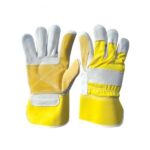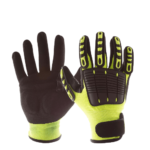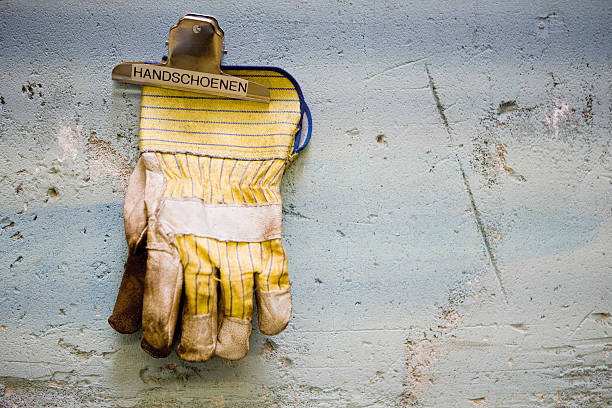<<10 Types of Prefect Hand Protection Gloves>>
Safety gloves are an integral part of the personal protective equipment (PPE) workers across various industries must wear to avoid being injured on the job. For these workers, gloves are a kind of second skin that allows them to handle hazardous materials, chemicals, and tools without sacrificing the dexterity they need to perform their work skillfully. Like all other safety equipment, however, gloves are not a generic product. For workers to be safe, they must be equipped with the right type of glove for the job they will be performing and the specific hazards they might encounter. There are a number of factors that go into selecting the right safety glove. But arguably the most important is the material that the glove is made from and the protection that material provides.
This article will go over 10 common types of safety glove to help you find the one that will meet your needs.
Hand Protection Requirements:
Adequate hand protection is not optional. Employers have a duty to provide their workers with all the PPE required to carry out their jobs safely. And this, of course, includes stocking every type of glove that is needed to protect every employee’s hands.
- General requirements. Employers shall select and require employees to use appropriate hand protection when employees’ hands are exposed to hazards such as those from skin absorption of harmful substances; severe cuts or lacerations; severe abrasions; punctures; chemical burns; thermal burns; and harmful temperature extremes.
- Selection. Employers shall base the selection of the appropriate hand protection on an evaluation of the performance characteristics of the hand protection relative to the task(s) to be performed, conditions present, duration of use, and the hazards and potential hazards identified
Types of Hand Protection Gloves:
»1)Fabric or Cotton Gloves:
These gloves act as a thin, breathable layer between the worker’s skin and the tools and materials they’re handling. Fabric gloves provide minimal protection against puncture hazards, jagged materials, open flames, and hot surfaces. However, they’re good for keeping hands clean and can prevent minor scrapes and abrasions.
Fabric gloves are sometimes used as liners worn inside larger safety gloves to provide additional warmth.
Although this style of glove is widely used, some coatings are known to become less flexible in colder work temperatures. They also provide less insulation than uncoated gloves.
Moreover, while coated fabric gloves offer some chemical resistance, they are not a substitute for a dedicated chemical glove when one is needed.
»2)Leather Gloves:
Leather gloves offer good grip, spark resistance, and protection against sharp or abrasive surfaces. They also protect the wearer from moderate levels of heat, such as the heat produced from welding or the friction from a rope sliding across the palms.
Leather gloves are highly durable when properly taken care of, but can harden or shrivel when exposed to excess heat. They can also dry out hands when they’re not worn with a liner.
»3)Kevlar Gloves:
Kevlar is a heat resistant synthetic fiber with a molecular structure of many inter-chain bonds that gives it its strength. This material has had a considerable impact on industrial hand protection, since it allows for the creation of lightweight and durable gloves with remarkable resistance to cuts and abrasions.
Kevlar is also used to make cut-resistant liners to support a variety of other glove styles.
»4)Puncture-Resistant Gloves:
These gloves are dedicated specifically to preventing a puncture to the hands. These can be woven Kevlar gloves or gloves which have been manufactured to emulate fish skin. The latter uses a scale- or flake-like structure to deflect penetration from needles, shards, and other puncture hazards.
»5)Impact-Resistant and Vibration-Resistant Gloves:
Vibrations may seem harmless, but prolonged exposure to them can cause harm. Safety professionals are becoming more and more aware of hand-arm vibration syndrome (HAVS) and the need to protect workers from it.
Some of that protection comes in the form of personal protective equipment. Specifically, gloves that absorb impact and reduce the hand’s exposure to vibrations.
Vibration-resistant gloves are used in fabrication work, where workers might make frequent use of grinders over the course of a shift. They are also prevalent in the construction and automotive industries, where jackhammers and other pneumatic tools might be used for extended periods of time.
»6)Liquid-Resistant Gloves:
Chemical absorption through the skin can lead to serious immediate or long-term health effects. Referring to a product’s safety data sheet will help you identify the proper level of protection required to keep workers safe while handling chemical products.
Below are a few examples of chemical- or liquid-resistant glove materials and their various applications.
»7)Butyl Rubber Glove:
These are typically used when workers will be in extended contact with a chemical substance. They also offer resistance to water and steam permeation.
Butyl rubber Glove is also used for protection against materials such as:
- Ketones, esters, alcohols
- Alkali
- Nitric acid
- Sulfuric acid
- Hydrochloric acid
- Peroxides
»8)Coated Fabric Gloves
These are general-purpose gloves that offer a higher level of puncture and cut resistance, protection from the alkalinity of concrete products, and improved chemical resistance compared to standard fabric gloves.
The coatings can be made from a variety of materials, including latex, nitrile, polyurethane, and PVC. The right coating for a given job can be determined by conducting a risk assessment.
Although this style of glove is widely used, some coatings are known to become less flexible in colder work temperatures. They also provide less insulation than uncoated gloves.
Moreover, while coated fabric gloves offer some chemical resistance, they are not a substitute for a dedicated chemical glove when one is needed.
»9)Aluminized Gloves:
Aluminized gloves are built for heat resistance. They are suitable for welding operations, furnace and foundry work, and in laboratories that use high-heat ovens. Their insulating and reflective properties can provide heat protection up to 2,000 degrees Fahrenheit.
»10)Nitrile Rubber:
Nitrile rubber is used to manufacture versatile, general-use gloves and can be suitable for incidental contact (such as disposable exam gloves). Thicker nitrile gloves are used in situations where extended contact is intended.
Nitrile gloves can protect the wearer from:
- Solvents
- Petroleum oils
- Gasoline
- Greases
- Some acids and bases
Safety Glove Selection Criteria:
Selecting the right glove for the job begins with an assessment of the specific risks and hazards the user is likely to encounter. This includes those that may appear minor – even a scrape or a cut could lead to an infection requiring medical intervention and days away from work.
Further considerations include:
- Size and fit: small gloves may tear while large gloves can affect dexterity
- Protection versus dexterity: sometimes a trade-off between these two factors is unavoidable and you will need to determine how to prioritize them
- Protection levels: gloves offer varying levels of protection against a given hazard and you must ensure that the glove meets the required level for the task
- Wear and tear: always check gloves for signs of physical damage, such as tears, discoloration, or swelling
- Expiration: never use a safety glove past its expiration date
Take Care. Visit Our Other Blogs & Product.
Any Question, Any Problem. Contact Us
Please Like, Share & Below Comment.
Thanks for Reading.
Read More: A PREFECT GUIDE ON SAFETY WORK GLOVES
















